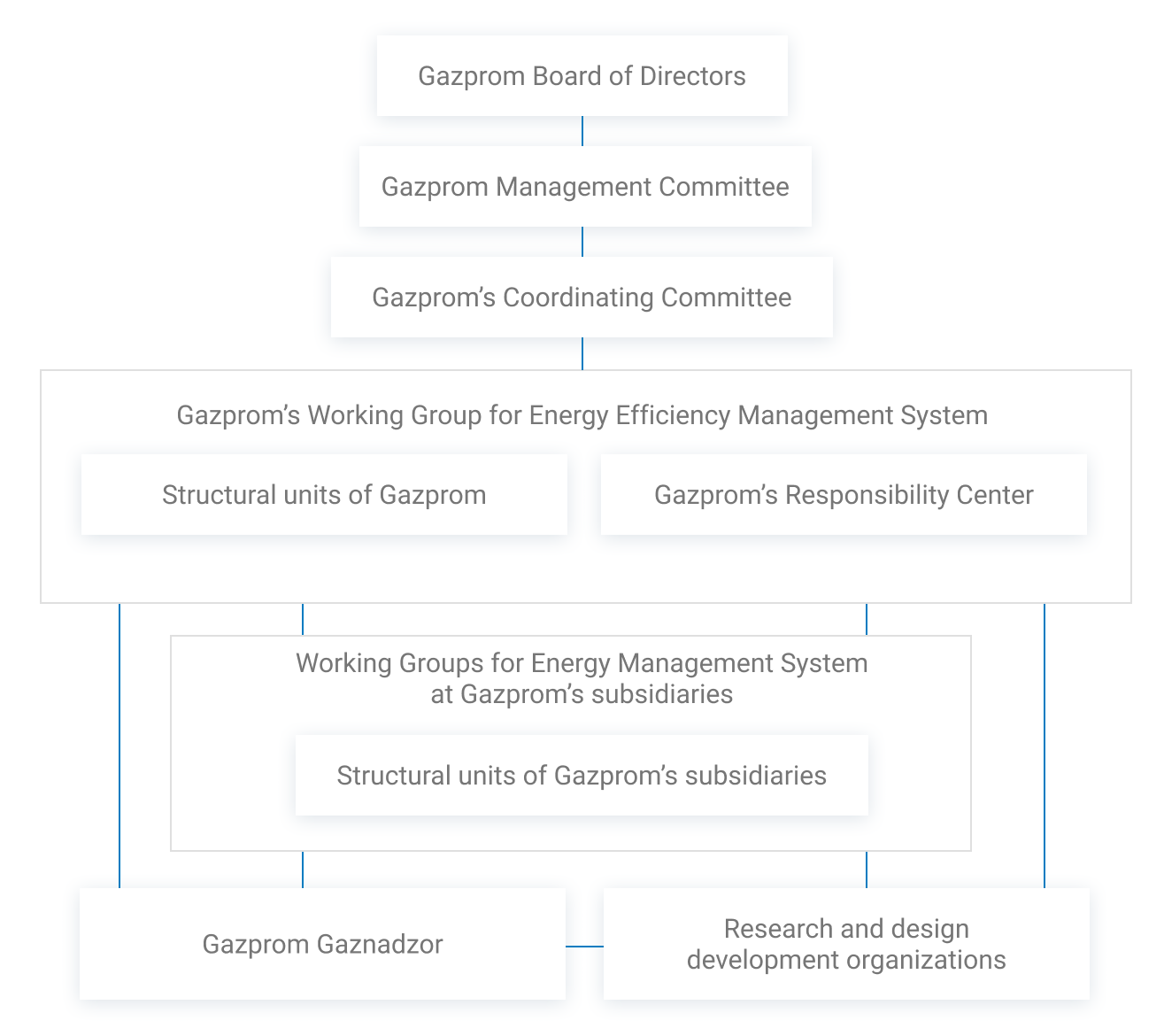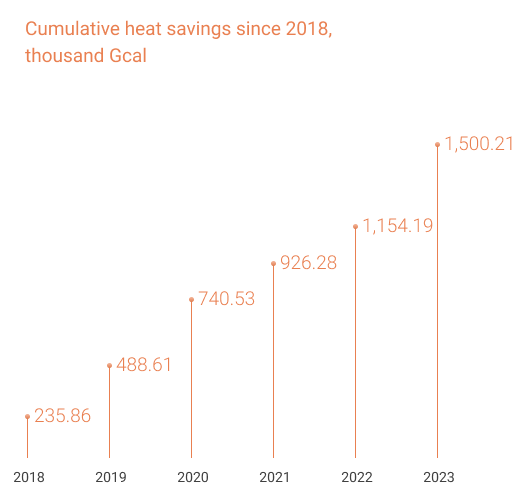Energy efficiency management system
Please direct questions relating to the Company’s Environmental Policy to Gazprom’s Press Service.
+7 812 729-47-60
Energy Efficiency Management System
The Energy Efficiency Management System is aimed at enhancing energy effectiveness, as well as at achieving a more efficient use of energy and reducing greenhouse gas emissions.
The Energy Efficiency Management System is embedded into the current management practices of the Company and forms an integral part of its corporate governance system. Retaining the logic and principles of continuous improvement, the system facilitates communication on efficient use of resources at different management levels and, as a result, ensures a better utilization of the energy saving potential at the subsidiaries.
The System covers the management of subsidiaries whose activities are connected with natural gas and gas condensate production and treatment; gas transmission and underground storage; energy, heat and/or water supply and operation of energy equipment of the facilities that form part of the Unified Gas Supply System; and hydrocarbon feedstock processing.
Extending to all levels of the management structure at Gazprom and 28 subsidiaries, the System makes them a single mechanism that serves to enhance energy effectiveness.

Energy Efficiency Management System Organizational Chart
Fuel and energy saving
As a result of the activities stipulated by the Energy Saving Program for 2023, the overall savings in terms of fuel and energy consumed for internal process needs amounted to 4,496,300 tons of fuel equivalent, including:
- natural gas – 3,719.7 million cubic meters;
- electricity – 389.3 million kWh;
- heat – 346,100 Gcal;
- vehicle fuel and petrol, oil & lubricants – 15,500 tons of fuel equivalent.
In 2023, the total economic benefit achieved through the implementation of Gazprom's Energy Saving and Energy Efficiency Program amounted to RUB 20.3 billion, the highest in the last five years.
As a result of the systematic work on the prevention of natural gas blowdowns during repair activities that is carried out under the corporate energy saving and energy efficiency programs, the annual amount of gas conservation was brought to 2.3–2.4 billion cubic meters in 2022–2023, which is a two-fold increase versus 2018.
As of the end of 2023, the specific consumption of fuel and energy resources in trunkline gas transmission was at 13.9 per cent relative to 2018 baseline; this shows that the relevant corporate target was achieved and the target indicators set out in the Energy Strategy of the Russian Federation until 2035 (approved by the Russian Government Order No. 1523-r dated June 9, 2020) were met.
| Activity | Natural gas, million cubic meters | Electricity, million kWh | Heat, thousand Gcal | Petrol, oil & lubricants and vehicle fuel, thousand tons of fuel equivalent | Total, thousand tons of fuel equivalent |
|---|---|---|---|---|---|
| Trunkline gas transmission | 3,049.4 | 330.9 | 105.9 | 13.1 | 3,664.4 |
| Gas production | 558.6 | 30.9 | 15.9 | 0 | 657.8 |
| Processing of gas and gas condensate | 77.0 | 13.8 | 220.1 | 0.1 | 126.3 |
| Gas distribution | 19.2 | 5.7 | 0.9 | 2.3 | 26.6 |
| Underground gas storage | 13.5 | 0.9 | 0 | 0 | 15.9 |
| Power, heat and/or water supplies, as well as operation of energy equipment of the UGSS facilities | 2 | 7.1 | 3.2 | 0 | 5.3 |
| Total | 3,719.7 | 389.3 | 346 | 15.5 | 4,496.3 |




Energy efficiency projects
The Company improves energy efficiency through the development and subsequent adoption of new technologies. A number of energy saving projects at various stages of implementation are currently underway, such as:
- use of mobile compressor stations for gas withdrawal and conservation before repair works;
- a project to install upgraded replaceable flow parts of centrifugal compressors;
- a gas ejection system serving to retain gas during gas blowdowns at compressor workshops;
- use of gas-oil heat exchangers in gas compressor units (heating of fuel gas by the heat generated by lubricating oil present in the gas turbine engine and compressor);
- implementation of variable frequency drives in forced-draft equipment of boiler houses;
- upgrade of air cooling units for gas, inter alia, through the use of composite materials;
- creation of a waste heat recovery plant based on the ORC technology for the generation of power to serve the internal needs of the relevant compressor station;
- replacement of the existing lighting with energy-efficient lighting;
- air cooling at the inlet of gas turbine engines;
- construction of a turboexpander generator at the Dobryanka-2 GDS.
As of the end of 2023, the portfolio of the existing and prospective energy saving projects financed through the investments of energy service companies grew to include 15 projects, and the total amount of investments in these projects exceeded RUB 11.5 billion.
Renewable and secondary energy sources
Gazprom supports the use of energy alternatives where it is economically and technically feasible, namely in remote or off-grid areas.
In 2023, the Gazprom Group operated 3,002 power units (excluding hydropower units) based on secondary energy sources and renewables, such as turbo-expanders, thermoelectric generators, solar modules and batteries, as well as wind turbines. The total amount of electricity generated by these units made up 4,861,100 kWh.
Alternative vehicle fuel
Gazprom is actively engaged in the conversion of vehicles to alternative fuels, which is a promising business line. As the most universal and affordable fuel, natural gas has the potential to replace petroleum products. It has environmental and economic advantages over conventional vehicle fuels.
There are more than 940 NGV refueling facilities in Russia, with over 400 of gas refueling infrastructure facilities being operated by Gazprom Gazomotornoye Toplivo.
In 2023, more than 10,000 motor vehicles were converted to NGV fuel across the Gazprom Group. As a result of the conversion of vehicles to natural gas, the overall consumption of compressed natural gas in Russia totaled 2.2 billion cubic meters in 2023, thus making it possible to reduce GHG emissions by 1 million tons of CO2 equivalent. Gazprom continues to implement the projects for the accelerated development of the gas filling network jointly with the administrations of Russian constituent entities. New refueling facilities for motor vehicles running on eco-friendly natural gas were launched in the Khabarovsk and Krasnodar Territories, the Yamal-Nenets Autonomous Area, the Republic of Bashkortostan, as well as in the Kaliningrad, Leningrad, Novosibirsk, Omsk, Rostov, Tula, and Vologda Regions. Over a half of the gas filling stations are owned by Gazprom. In 2023, the sales of NGV fuel at said stations accounted for more than 70 per cent of the total volume of natural gas as a vehicle fuel sold in Russia.
With the addition of 11 more facilities, the number of Gazprom's franchise compressed natural gas filling stations reached 25 in 2023. The first CNG filling stations operating under the franchise of Gazprom Gazomotornoye Toplivo started refueling motor vehicles with methane in the Kursk and Nizhny Novgorod Regions in late 2023. In 2024, it is planned to extend the franchising program to cover the Krasnodar Region, the Republic of Bashkortostan, as well as the Chelyabinsk, Omsk, Rostov, Sverdlovsk, Tula, Tyumen, and Yaroslavl Regions. Gazprom plans to build more than 200 gas filling stations before the end of 2025. Particular attention will be given to creating a core gas filling network along key federal highways.
Gazprom has agreements with the largest automakers to expand their product lines with natural gas-powered vehicle models, inter alia, for the Company's own needs. At present, Russian factories manufacture over 230 natural gas-powered vehicle models, which include passenger cars, trucks, buses, and special-purpose vehicles. The NGV fleet of the Russian Federation comprises about 285,000 vehicles; therefore, an annual increase of the demand for NGV fuel is observed. At the initiative of Gazprom, KAMAZ has launched the batch production of a wide range of natural gas-powered cars and machinery. Today, the automobile plant produces about 130 models of such motor vehicles, which makes over a half of the entire range of NGVs currently offered by Russian manufacturers.
Gazprom and the Ministry of Agriculture of the Russian Federation signed the Agreement of Cooperation with regard to the use of natural gas as a vehicle fuel in the domestic agro-industrial complex, the establishment of a long-term mutually beneficial business partnership to create state support measures for agricultural producers, manufacturers of natural gas-powered agricultural machinery and manufacturers of mobile NGV refuelers, as well as the expansion of the lineup of agricultural NGVs and mobile gas filling infrastructure. It was taken into account that natural gas is the most cost-effective fuel, which makes it possible to cut costs by over half as compared to gasoline or diesel fuel and thus reduce the prime cost of agricultural products. According to expert estimates, the potential consumption of gas as vehicle fuel in Russia's agro-industrial complex is 300–400 million cubic meters of gas per year. More possibilities also emerge for the use of NGV fuel in the mining sector.
Gazprom takes extensive efforts to convert its own vehicle fleet to gas. Today, more than 14,000 motor vehicles, which make up 63 per cent of the vehicle fleet owned by the Company's core subsidiaries, are NGVs. In parallel, Gazprom is exploring the potential applications of gas in other kinds of transport, such as railway and waterborne transport. The TEMG1 shunter, which is Russia's first shunter powered by liquefied natural gas, was custom-developed for Gazprom and is currently under pilot operation.
Among the priorities set by Gazprom for 2024 are the increase of sales of natural gas as a vehicle fuel, which means a larger contribution to the economy and the environmental well-being of Russia, as well as the improvement of operational reliability and efficiency of the existing gas filling network. The NGV Fuel Market Development subprogram envisages increasing the consumption of natural gas as a vehicle fuel in 2024 to 2.7 billion cubic meters, expanding the NGV fleet by at least 40,000 vehicles, as well as developing the network of gas filling stations to reach 1,273 by the end of 2024.
Associated petroleum gas
Measures aimed at reducing (ceasing) associated petroleum gas (APG) flaring are highly important to saving energy resources and cutting greenhouse gas emissions.
The Gazprom Group implements investment projects for APG on-site utilization with the purpose of attaining an APG utilization level of no less than 95 per cent (pursuant to the Russian Government Directive No. 7 dated January 8, 2009).
In 2023, the level of beneficial use of APG was 99.0 per cent for the fields of Gazprom's gas production subsidiaries (including Gazprom Dobycha Tomsk), 94.5 per cent for the Gazprom Neft Group, and 97.3 per cent for Sakhalin Energy.








